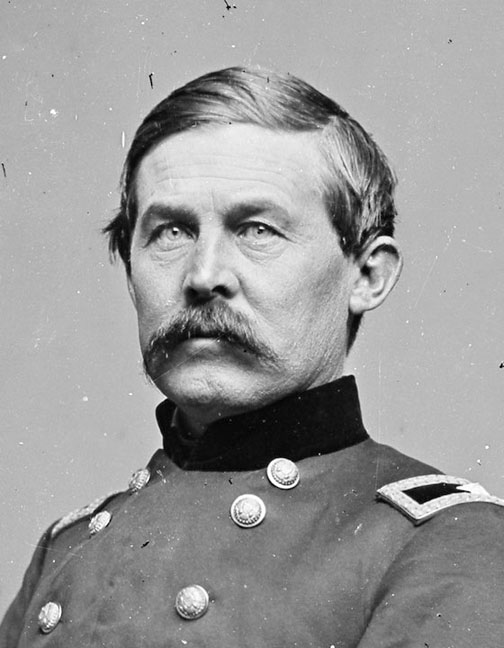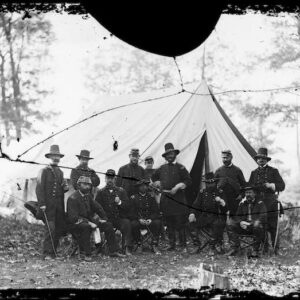Tag: Buford (John)
 Wikipedia says: John Buford, Jr. (March 4, 1826 – December 16, 1863) was a United States Army cavalry officer. He fought for the Union as a brigadier general during the American Civil War. Buford is best known for having played a major role in the first day of the Battle of Gettysburg on July 1, 1863, by obtaining the ‘high ground’ while in command of a division.
Wikipedia says: John Buford, Jr. (March 4, 1826 – December 16, 1863) was a United States Army cavalry officer. He fought for the Union as a brigadier general during the American Civil War. Buford is best known for having played a major role in the first day of the Battle of Gettysburg on July 1, 1863, by obtaining the ‘high ground’ while in command of a division.
Buford graduated from West Point in 1848. Buford remained loyal to the United States when the Civil War broke out, despite having been born in the divided border state of Kentucky. During the war he fought against the Confederate Army of Northern Virginia as part of the Army of the Potomac. His first command was a cavalry brigade under Major General John Pope, and he distinguished himself at Second Bull Run in August 1862, where he was wounded, and also saw action at Antietam in September and Stoneman’s Raid in spring 1863.
Buford’s cavalry division played a crucial role in the Gettysburg Campaign that summer. Arriving at the small town of Gettysburg, Pennsylvania on June 30 before the Confederate troops, Buford set up defensive positions. On the morning of July 1, Buford’s division was attacked by a Confederate division under the command of Major General Henry Heth. His men held just long enough for Union reinforcements to arrive. After a massive three day battle, the Union troops emerged victorious. Later, Buford rendered valuable service to the Army, both in the pursuit of Robert E. Lee after the Battle of Gettysburg, and in the Bristoe Campaign that autumn, but his health started to fail, possibly from typhoid. Just before his death at age 37, he received a personal message from President Abraham Lincoln, promoting him to major general of volunteers in recognition of his tactical skill and leadership displayed on the first day of Gettysburg.
…Throughout 1860, Buford and his fellow soldiers had lived with talk of secession and the possibility of civil war until the Pony Express brought word that Fort Sumter had been fired upon in April 1861, confirming secession as fact. As was the case with many West Pointers, Buford had to choose between North and South. Based on his background, Buford had ample reason to join the Confederacy. He was a native Kentuckian, the son of a slave-owning father, and the husband of a woman whose relatives would fight for the South, as would a number of his own. On the other hand, Buford had been educated in the North and come to maturity within the Army. His two most influential professional role models, Colonels William S. Harney and Philip St. George Cooke, were Southerners who elected to remain with the Union and the U.S. Army. He loved his profession and his time on the frontier had snapped the ties that drew other Southerners home.
John Gibbon, a North Carolinian facing the same dilemma, recalled in a post-war memoir the evening that John Buford committed himself to the Union:
One night after the arrival of the mail we were in his (Buford’s) room, when Buford said in his slow and deliberate way “I got a letter from the Governor of Kentucky. He sent me word to come to Kentucky at once and I shall have anything I want.” With a good deal of anxiety, I (Gibbon) asked “What did you answer, John?” And my relief was great when he replied “I sent him word I was a Captain in the United States Army and I intended to remain one!”
In November 1861, Buford was appointed Assistant Inspector General with the rank of major, and, in July 1862, after having served for several months in the defense of Washington, was raised to the rank of brigadier general of volunteers. In 1862, he was given his first position, under Major General John Pope, as commander of the II Corps Cavalry Brigade of the Union Army of Virginia, which fought with distinction at the Second Battle of Bull Run. Buford personally led a charge late in the battle, but was wounded in the knee by a spent bullet. The injury was painful, but not serious, although some Union newspapers reported that he had been killed. He returned to active service, and served as chief of cavalry to Major Generals George B. McClellan and Ambrose E. Burnside in the Army of the Potomac. Unfortunately, this assignment was nothing more than a staff position, and he chafed for a field command. In McClellan’s Maryland Campaign, Buford was in the battles of South Mountain and Antietam, replacing Brigadier General George Stoneman on McClellan’s staff. Under Major General Joseph Hooker in 1863, however, Buford was given the Reserve Brigade of regular cavalry in the 1st Division, Cavalry Corps of the Army of the Potomac.
After the Battle of Chancellorsville, Major General Alfred Pleasonton was given command of the Cavalry Corps, although Hooker later agreed that Buford would have been the better choice. Buford first led his new division at the Battle of Brandy Station, which was virtually an all-cavalry engagement, and then again at the Battle of Upperville.
In the Gettysburg Campaign, Buford, who had been promoted to command of the 1st Division, is credited with selecting the field of battle at Gettysburg. On June 30, Buford’s command rode into the small town of Gettysburg. Very soon, Buford realized that he was facing a superior force of rebels to his front and set about creating a defense against the Confederate advance. He was acutely aware of the tactical importance of holding the high ground south of Gettysburg, and so he did, beginning one of the most important battles in American military history. His skillful defensive troop dispositions, coupled with the bravery and tenacity of his dismounted men, allowed the I Corps, under Major General John F. Reynolds, time to come up in support and thus maintain a Union foothold in tactically important positions. Despite Lee’s barrage attack of 140 cannons and a final infantry attack on the third day of the battle, the Union army won a strategic victory. The importance of Buford’s leadership and tactical foresight on July 1 cannot be overstated in its contribution to this victory. Afterward, Buford’s troopers were sent by Pleasonton to Emmitsburg, Maryland, to resupply and refit, an ill-advised decision that uncovered the Union left flank.
In the Retreat from Gettysburg, Buford pursued the Confederates to Warrenton, Virginia, and was afterward engaged in many operations in central Virginia, rendering particularly valuable service in covering Major General George Meade’s retrograde movement in the October 1863 Bristoe Campaign.
The hero at Oak Ridge was John Buford… he not only showed the rarest tenacity, but his personal capacity made his cavalry accomplish marvels, and rival infantry in their steadfastness… Glorious John Buford!
— Maj. Gen. John Watts de Peyster on Buford’s Dragoon tactics
Buford despised the false flourish and noisy parade of the charlatans of his service. He avoided too, perhaps, the proper praise due his glorious actions, his bravery and dash, without ostentation or pride, his coolness and able management and above all, the care of his men endeared him to all.
— Theo. F. Rodenbough, Brevet Brigadier General
Showing the single result
